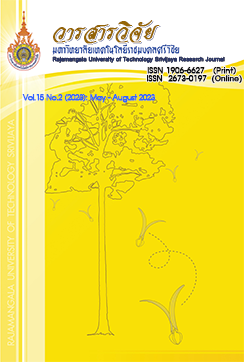Calcium Lactate Application for Delay Browning and Deterioration of Fresh-Cut Romaine Lettuce
Keywords:
fresh-cut romaine lettuce, calcium Lactate, browning reaction, deteriorationAbstract
Browning symptom in fresh-cut romaine lettuce is an important problem, affecting quality and consumer acceptance. This research is to study the effects of 1.5% calcium lactate delay browning and deterioration of fresh-cut romaine lettuce. These results showed that the fresh-cut romaine lettuce immersed in calcium lactate for 10 minutes had inhibited browning efficiency compared to non-treated calcium lactate (Control). Lower browning index was directly associated with a decrease in phenolic compounds, enzyme activities of Phenylalanine ammonialyase (PAL), Polyphenol oxidase (PPO) and Peroxidase (POD) in contrast with the control. Additionally, deterioration of membrane cells can investigate the increase of enzyme activity of Lipoxygenase (LOX), content of Hydrogen peroxide (H2O2) and Malondialdehyde (MDA). This research showed that the use of calcium lactate solution can reduce the accumulation of MDA content, hydrogen peroxide and enzyme activity of LOX. Hence, the use of calcium lactate in fresh-cut romaine lettuce can delay browning and deterioration.
References
Alandes, L., Pérez-Munuera, I., Llorca, E., Quiles, A. and Hernando, I. 2009. Use of calcium lactate to improve structure of “Flor de Invierno” fresh-cut pears. Postharvest Biology and Technology 53: 145-151.
Babenko, L.M., Shcherbatiuk, M.M., Skaterna, T.D. and Kosakivska, I.V. 2017. Lipoxygenases and their metabolites in formation of plant stress tolerance. The Ukrainian Biochemical Journal 89: 1-211.
Baysal, T. and Demirdoven, A. 2007. Lipoxygenase in fruits and vegetables: A review. Enzyme and Microbial Technology 40(4): 491-496.
Bradford, M.M. 1976. A rapid and sensitive method for the quantification of microgram quantities of protein utilizing the principle of protein-dye binding. Analytical Biochemistry 72: 248-254.
Castillo, F.I., Penel, I. and Greppin, H. 1984. Peroxidase release induced by ozone in Sedum album leaves: involvement of Ca2+. Plant Physiology 74: 846-851.
Chutichudet, B., Chutichudet, P. and Kaewsit, S. 2011. Influence of developmental stage on activities of polyphenol oxidase, internal characteristics and color of lettuce cv. Grand Rapids. American Journal of Food Technology 6(3): 215-225.
Demidchik, V., Shabala, S., Isayenkov, S., Cuin, T.A. and Pottosin, I. 2018. Calcium transport across plant membranes: mechanisms and functions. New Phytologist 220: 49-69.
Galeazzi, M.A.M. and Sgarbieri, V.C. 1981. Substrate specificity and inhibition of polyphenol oxidase (PPO) from a dwarf variety of banana (Musa cavendishii L.). Journal of Food Science 46: 1404-1406.
He, Q. and Luo, Y. 2007. Enzymatic browning and its control in fresh-cut produce. Stewart Postharvest Review 3(6): 1-7.
Hodges, D.M., DeLong, J.M., Forney, C.F. and Prange, R.K. 1999. Improving the thiobarbituric acid-reactive-substances assay for estimating lipid peroxidation in plant tissues containing anthocyanin and other interfering compounds. Planta 207: 604-611.
Iakimova, E.T. and Woltering, E.J. 2018. The wound response in fresh-cut lettuce involves programmed cell death events. Protoplasma 255: 1225-1238.
Ke, D. and Saltveit, M.E. 1989. Wound-induced ethylene production, phenolic metabolism and susceptibility to russet spotting in iceberg lettuce. Physiological Plant 76: 412-418.
Ketsa, S. and Atantee, S. 1998. Phenolics, lignin, peroxidase activity and increased firmness of damaged pericarp of mangosteen fruit after impact. Postharvest Biology and Technology 14: 117-124.
Maalekuu, K., Elkind, Y., Leikin-Frenkel, A., Lurie, S. and Fallik, E. 2006. The relationship between water loss, lipid content, membrane integrity and LOX activity in ripe pepper fruit after storage. Postharvest Biology and Technology 42: 248-255.
Martin-Diana, A.B., Rico, D., Frias, J.M., Barat, J.M., Henehan, G.T.M. and Barry-Ryan, C. 2005. Calcium for extending the shelf life of fresh whole and minimally processed fruits and vegetables: a review. Trends in Food Science and Technology 18: 210-218.
Martinez, M.V. and Whitaker, J.R. 1995. The biochemistry and control of enzymatic browning. Trends in Food Science and Technology 6(6): 195-200.
Moon, K.M., Kwon, E.B., Lee, B. and Kim, C.Y. 2020. Recent trends in controlling the enzymatic browning of fruit and vegetable products. Molecules 25: 1-15.
Peiser, G., López-Gálvez, G., Cantwell, M. and Saltveit, M.E. 1998. Phenylalanine ammonia lyase inhibitors control browning of cut lettuce. Postharvest Biology and Technology 14: 171-77.
Pen, L.T. and Jiang, Y.M. 2003. Effects of chitosan coating on shelf life and quality of fresh-cut Chinese water chestnut. LWT-Food Science and Technology 36: 359-364.
Razzoli, M., Frontini, A., Gurney, A., Mondini, E., Cubuk, C., Katz, L.S., Cero, C., Bolan, P.J., Dopazo, J., Vidal-Puig, A., Cinti, S. and Bartolomucci, A. 2015. Stress-induced activation of brown adipose tissue prevents obesity in conditions of low adaptive thermogenesis. Molecular Metabolism 5(1): 1-15.
Rico, D., Martin-Diana, A.B., Henehan, G.T.M., Frias, J., Barat, J.M. and Barry-Ryan, C. 2007. Improvement in texture using calcium lactate and heat-shock treatments for stored ready-to-eat carrots. Journal of Food Engineering 79: 1196-1206.
Schmidt, A. and Kunert, K.J. 1986. Lipid peroxidation in higher plants: the role of glutathione reductase. Plant Physiology 82: 700-702.
Sharma, P., Jha, A.B., Dubey, R.S. and Pessarakli, M. 2012. Reactive oxygen species, oxidative damage, and antioxidative defense mechanism in plants under stressful conditions. Journal of Botany 217037: 1-26.
Shewfelt, R.L. and Rosario, B.A.D. 2000. The role of lipid peroxidation in storage disorders of fresh fruits and vegetables. HortScience 35(4): 575-579.
Velikova, V., Yordanov, I. and Edreva, A. 2000. Oxidative stress and some antioxidant systems in acid rain-treated bean plants: Protective role of exogenous polyamines. Plant Science 151:59-66.
Downloads
Published
How to Cite
Issue
Section
License
Copyright (c) 2023 Rajamangala University of Technology Srivijaya Research Journal

This work is licensed under a Creative Commons Attribution-NonCommercial-NoDerivatives 4.0 International License.
The content and information in the article published in Journal of Rajamangala University of Technology Srivijaya It is the opinion and responsibility of the author of the article. The editorial journals do not need to agree. Or share any responsibility.







